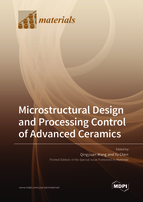Microstructural Design and Processing Control of Advanced Ceramics
A special issue of Materials (ISSN 1996-1944). This special issue belongs to the section "Advanced and Functional Ceramics and Glasses".
Deadline for manuscript submissions: closed (10 April 2022) | Viewed by 19275
Special Issue Editors
Interests: very high cycle fatigue (VHCF) & fracture; mechanics of advanced materials and structures
Special Issue Information
Dear Colleagues,
Advanced ceramics are referred to in various parts of the world as technical ceramics, high-tech ceramics, and high-performance ceramics. They represent an important technology which has considerable impact for a large variety of industries, branches, and markets. It is considered an enabling technology which has the potential to deliver high-value contributions for solving the challenges of our future. From a general point of view, the advanced ceramics sector comprises the following categories:
- Functional ceramics: Electrical and magnetic ceramics (i.e., dielectrics, piezoelectrics, ferromagnetics), ionic conductors, and superconductive ceramics;
- Structural ceramics: Monoliths and composites, e.g., oxides, nitrides, carbides, borides, and composite materials based on these materials;
- Bioceramics, e.g., hydroxyapatite and alumina;
- Ceramic coatings: Oxides, nitrides, carbides, borides, cermets, and diamond-like coatings, deposited by technologies such as spraying, vapor deposition, and sol–gel coating;
- Special glasses: processed flat glass, fire-resistant glazing, and glasses for optoelectronics.
First, advanced ceramics tend to lack a glassy component, i.e., they are “basically crystalline”. Second, microstructures are usually highly engineered, meaning that grain sizes, grain shapes, porosity, and phase distributions (for instance, the arrangements of second phases such as whiskers and fibers) can be carefully planned and controlled. Such planning and control require “detailed regulation” of composition and processing. Finally, such advanced ceramics with both well-designed microstructures tend to exhibit unique or superior functional attributes that can be “precisely specified” by careful processing and quality control. Examples include unique electrical properties such as superconductivity or superior mechanical properties, such as enhanced toughness or high-temperature strength.
Because of the attention to microstructural design and processing control, advanced ceramics are often high value-added products. Developments in advanced ceramic processing continue at a rapid pace, constituting what can be considered a revolution in the kind of materials and properties obtained.
Prof. Dr. Qingyuan Wang
Dr. Yu Chen
Guest Editors
Manuscript Submission Information
Manuscripts should be submitted online at www.mdpi.com by registering and logging in to this website. Once you are registered, click here to go to the submission form. Manuscripts can be submitted until the deadline. All submissions that pass pre-check are peer-reviewed. Accepted papers will be published continuously in the journal (as soon as accepted) and will be listed together on the special issue website. Research articles, review articles as well as short communications are invited. For planned papers, a title and short abstract (about 100 words) can be sent to the Editorial Office for announcement on this website.
Submitted manuscripts should not have been published previously, nor be under consideration for publication elsewhere (except conference proceedings papers). All manuscripts are thoroughly refereed through a single-blind peer-review process. A guide for authors and other relevant information for submission of manuscripts is available on the Instructions for Authors page. Materials is an international peer-reviewed open access semimonthly journal published by MDPI.
Please visit the Instructions for Authors page before submitting a manuscript. The Article Processing Charge (APC) for publication in this open access journal is 2600 CHF (Swiss Francs). Submitted papers should be well formatted and use good English. Authors may use MDPI's English editing service prior to publication or during author revisions.
Keywords
- advanced ceramics
- chemical composition
- microstructural design
- processing control
- high-performance
- multifunction








